Tsukemono, or Japanese pickles, are an iconic part of Japan’s food culture. Beyond their vibrant appearance, they embody rich fermentation traditions, nutrition, and preservation techniques that have fascinated chefs and health enthusiasts worldwide. This article explores what tsukemono are, their varieties, health benefits, modern uses, and global significance.
What Is Tsukemono? – Japanese Pickles Defined
Tsukemono literally means “pickled things” in Japanese. Unlike typical Western pickles, tsukemono encompass a diverse range of preservation methods, including fermentation, salting, and vinegar pickling. They are not only a way to extend shelf life but a cultural symbol reflecting Japan’s culinary artistry.
- Tsukemono = Japanese pickles
- Two main types: fermented and non-fermented
- Historically used for food preservation; now valued for flavor and health (However, there are some points to note.)
Types of Tsukemono: Fermented and non-fermented
Japanese tsukemono come in many forms, influenced by ingredients, regional climate, and tradition. Here are ten common types, introduced by their Japanese names, with details on their pickling method, microbes involved, and a brief preparation overview.
Takuan (Pickled Daikon Radish)
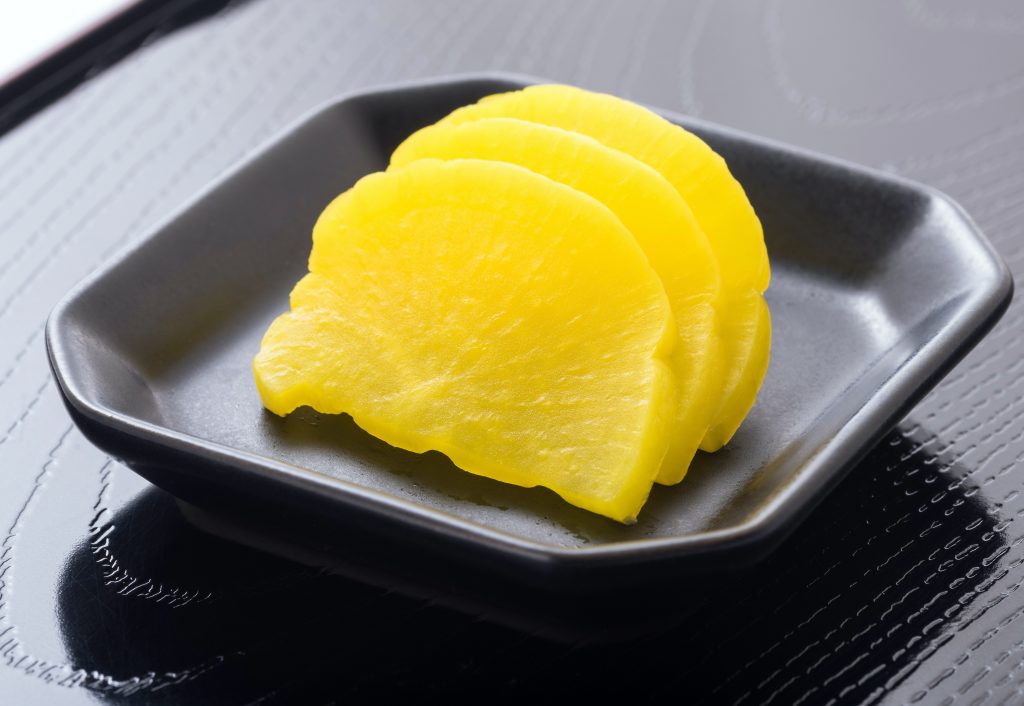
- Pickling method: Nukazuke (rice bran fermentation)
- Microbes: Lactic acid bacteria (LAB)
- Preparation: Daikon radish is dried then buried in a bed of rice bran mixed with salt and sometimes sugar, fermented for several months, developing a mellow sourness and crunchy texture.
Umeboshi (Pickled Japanese Plum)
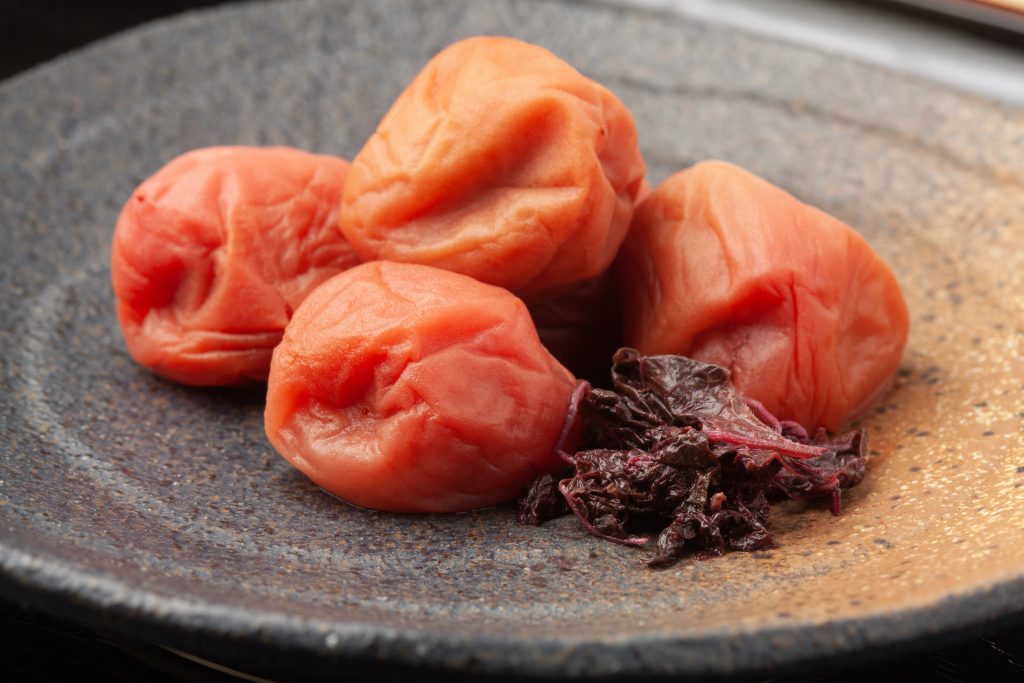
- Pickling method: Salt pickling with red shiso leaves
- Microbes: None (non-fermented)
- Preparation: Plums are salted heavily, layered with red shiso leaves for color and flavor, then sun-dried. The process can take several weeks, resulting in intensely sour and salty plums.
Gari (Pickled Ginger)
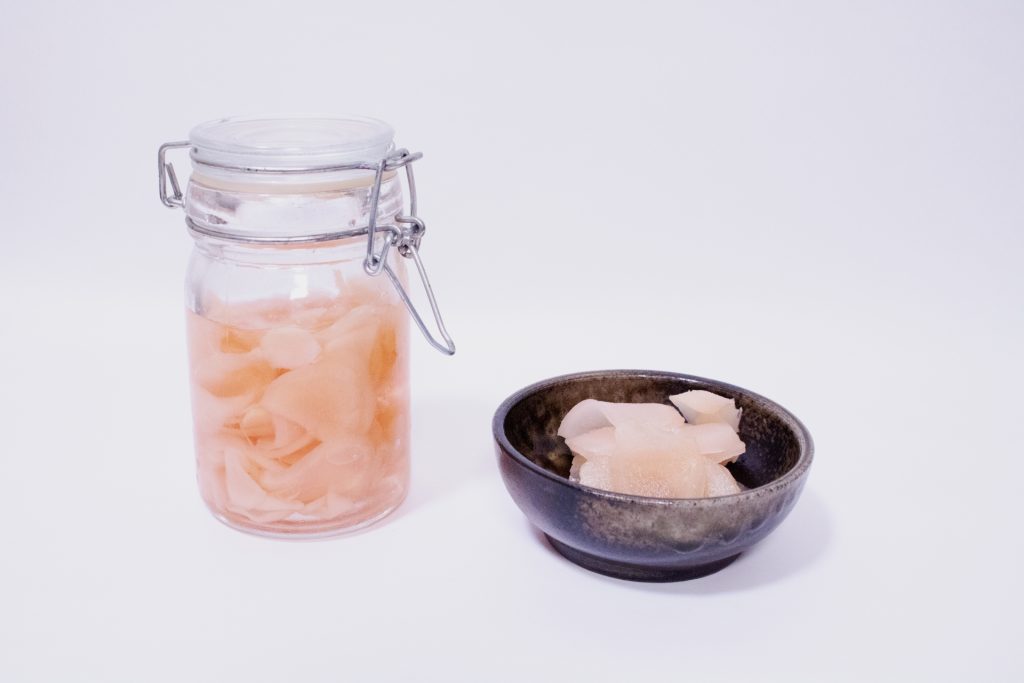
- Pickling method: Vinegar pickling
- Microbes: None (non-fermented)
- Preparation: Thinly sliced young ginger is quickly pickled in a sweetened rice vinegar solution, maintaining its pink color and crisp texture, commonly served as a palate cleanser with sushi.
Fukujinzuke (Mixed Vegetable Pickle)
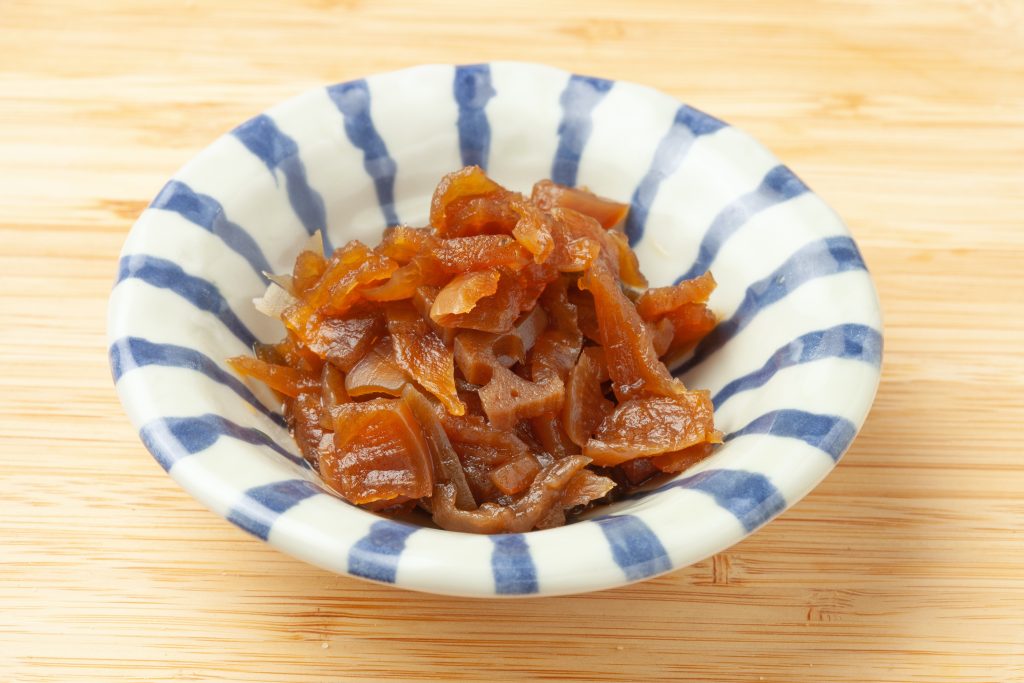
- Pickling method: Soy sauce-based sweet vinegar pickling (non-fermented)
- Microbes: None (non-fermented)
- Preparation: A mixture of finely chopped vegetables like daikon, lotus root, and eggplant are pickled in a soy sauce, sugar, and vinegar blend, creating. Fukujinzuke, which is often eaten with curry, is red in color, but this is because red coloring agents such as red yeast rice are used.
Shibazuke (Pickled Eggplant and Cucumber)
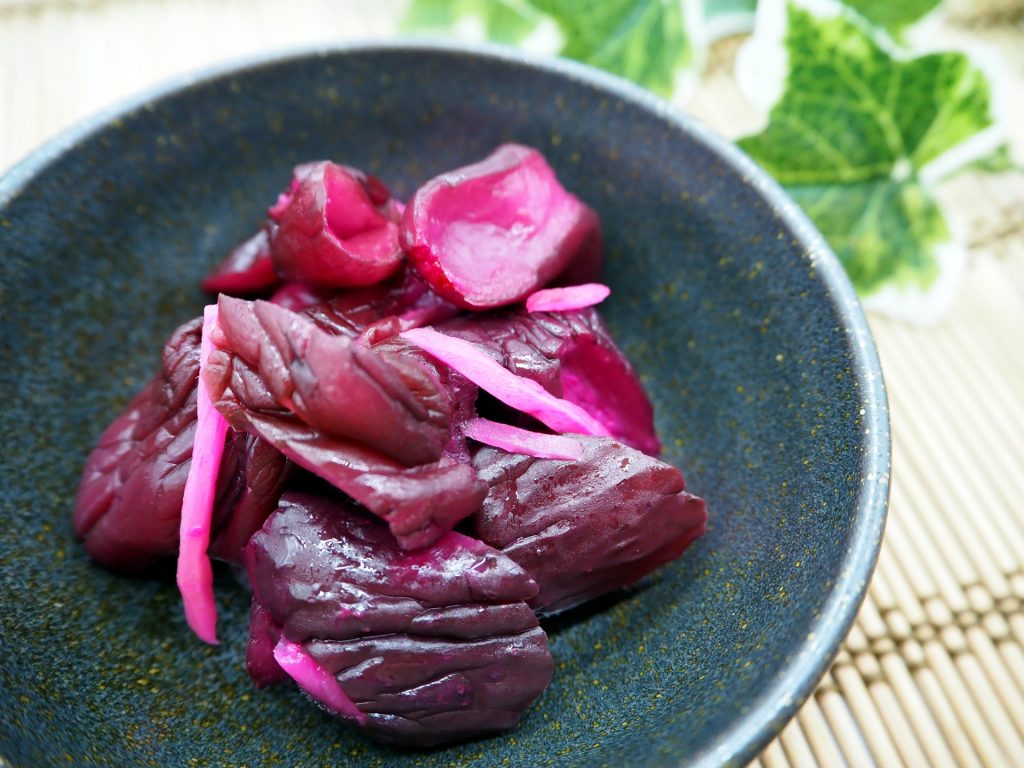
- Pickling method: Lactic acid fermentation with red shiso
- Microbes: Lactic acid bacteria
- Preparation: Eggplants and cucumbers are salted and mixed with red shiso leaves, then fermented for a few weeks, producing a purple-hued pickle with a sour, refreshing flavor.
Narazuke (Pickled Vegetables in Sake Lees)
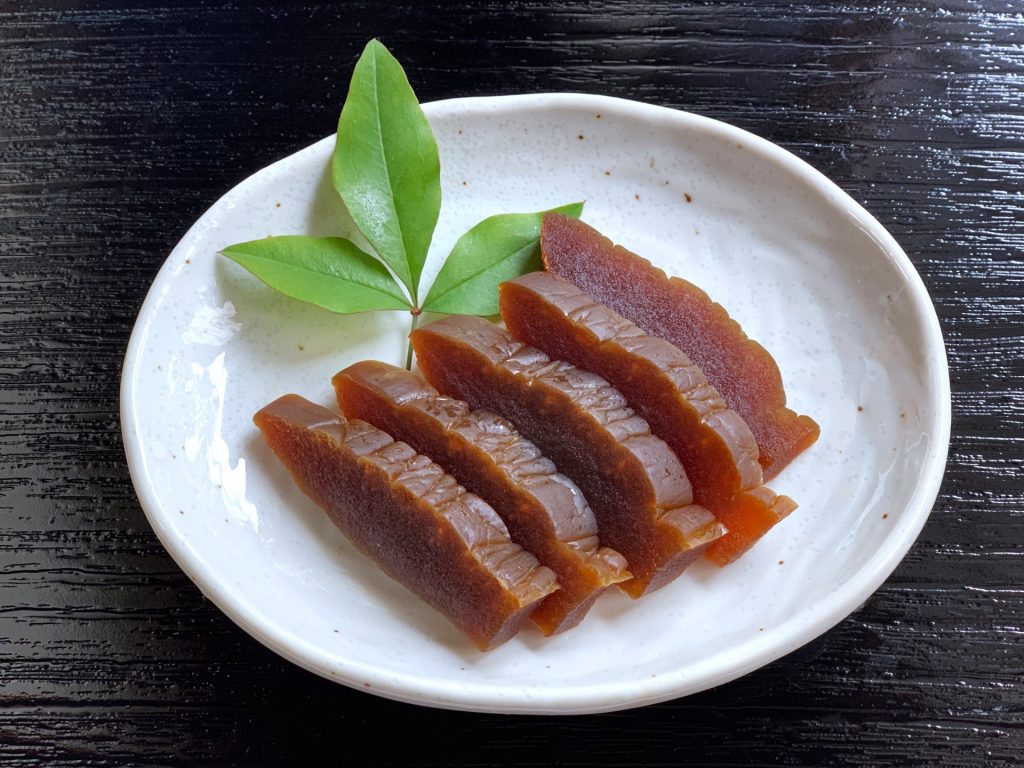
- Pickling method: Fermentation in sake lees (sake kasu)
- Microbes: Yeasts and lactic acid bacteria
- Preparation: Vegetables like cucumber and watermelon are soaked in sake lees for months to years, absorbing alcohol and developing a rich umami flavor with a slightly alcoholic aroma.
Senmaizuke (Thinly Sliced Pickled Turnip)
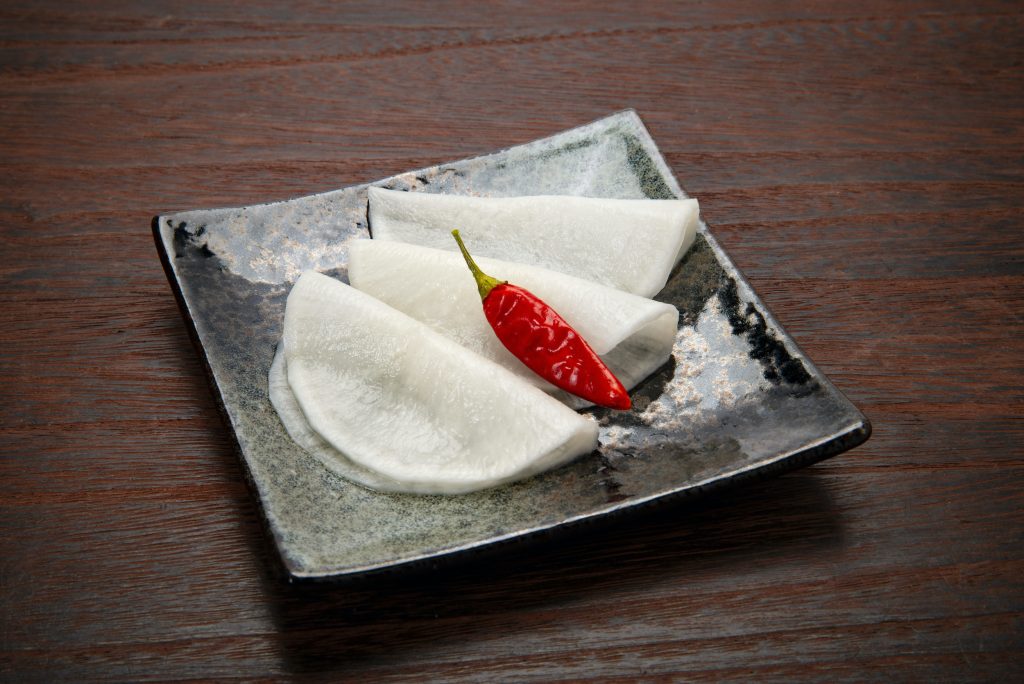
- Pickling method: Nowadays salting is the norm, but in the past, it was salted and then fermented with lactic acid.
- Microbes: None (non-fermented) or Lactic acid bacteria
- Preparation: Thin slices of turnip are lightly salted then pickled in a sweet vinegar mixture with kombu seaweed, resulting in a crisp, mild pickle popular in Kyoto cuisine.
Nozawana-zuke (Pickled Nozawana Greens)
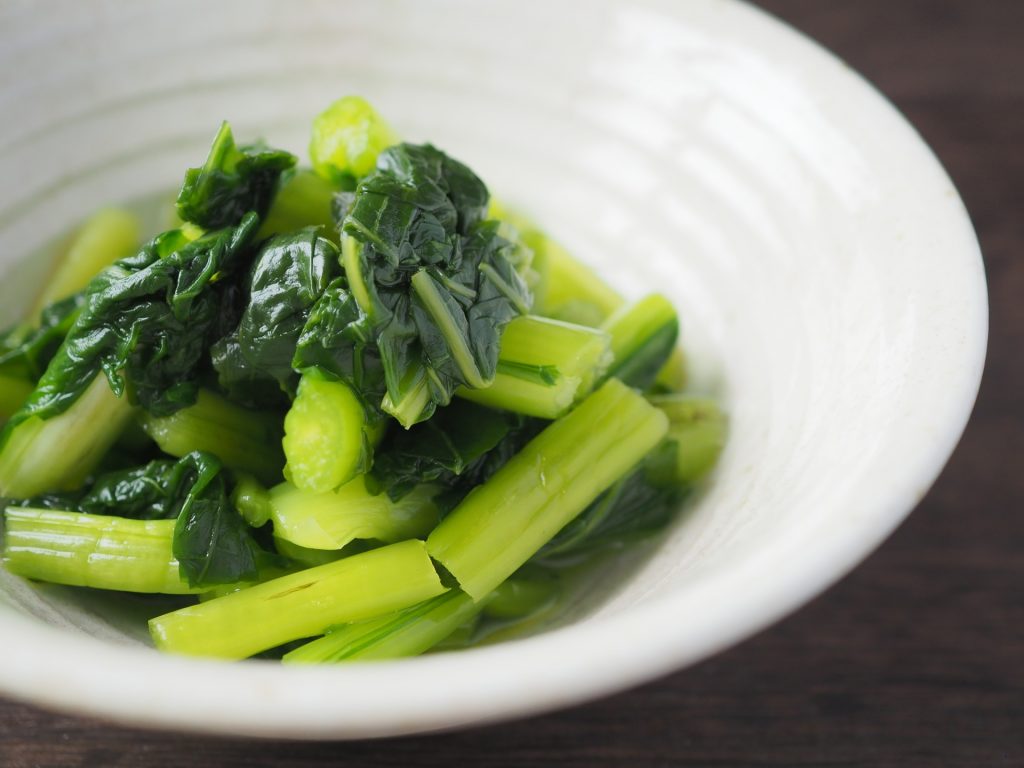
- Pickling method: Salt pickling with lactic acid fermentation
- Microbes: Lactic acid bacteria
- Preparation: Nozawana greens are salted and fermented for several weeks in cooler climates, creating a tangy, slightly spicy pickle enjoyed as a staple in Nagano prefecture.
Hakusai-zuke (Pickled Chinese Cabbage)
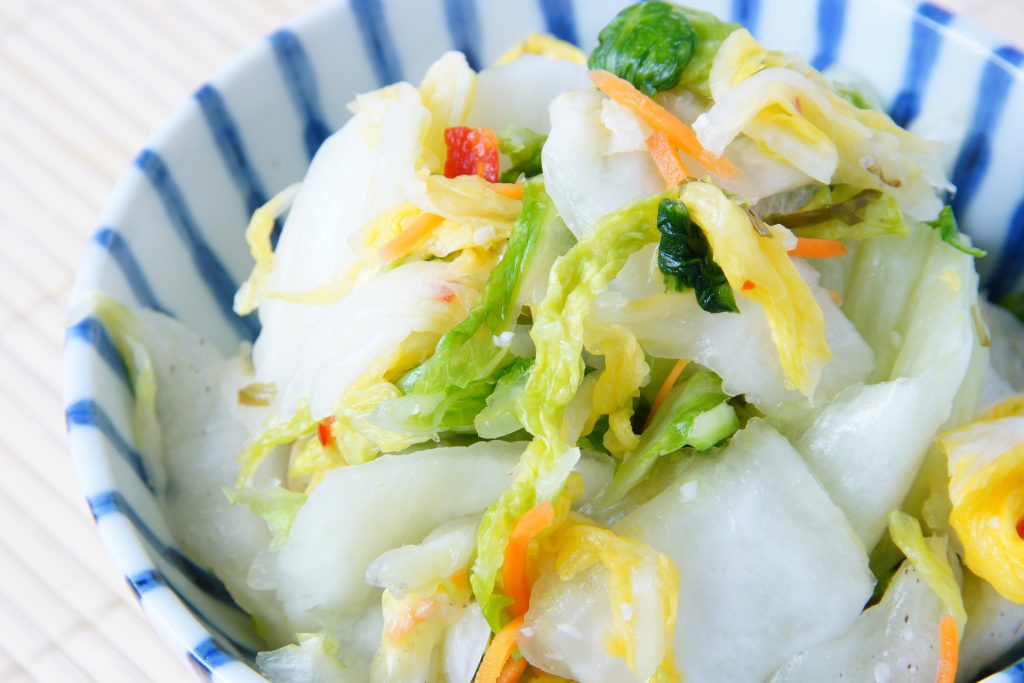
- Pickling method: Salt or light fermentation (short-term)
- Microbes: Lactic acid bacteria (short fermentation) or none for quick pickles
- Preparation: Chinese cabbage is salted and pressed, sometimes fermented briefly or served as a quick salt pickle, yielding a crunchy, mild pickle often served in winter.
Kyuri Asazuke (Quick Pickled Cucumbers)
- Pickling method: Light salt and vinegar pickling (non-fermented or very short fermentation)
- Microbes: Minimal or none
- Preparation: Cucumbers are salted lightly with added kombu or chili, pickled for a few hours to a day, offering a crisp and fresh-tasting side dish.
Fermented vs Non-Fermented Pickles
Tsukemono can be broadly divided into fermented and non-fermented categories.
- Fermented: Involves beneficial microbes such as lactic acid bacteria and yeasts, which break down sugars into acids, enhancing flavor and health benefits. Examples: takuan, shibazuke, nozawana-zuke.
- Non-fermented: Use vinegar or salt for quick pickling without microbial fermentation. Examples: gari, fukujinzuke, senmaizuke.
Fermented pickles contribute to gut health by supplying probiotics, while non-fermented types are prized for their crisp texture and refreshing flavors.
How Regional Varieties Reflect Japanese Food Culture
Each region in Japan has developed its own tsukemono styles based on local ingredients, climate, and traditions.
- Nagano’s Nozawana-zuke: Reflects cold climate fermentation for preservation.
- Kyoto’s Senmaizuke: Celebrates delicate flavor using local turnips and vinegar.
- Nara’s Narazuke: Uses sake lees, an old method linking sake brewing and pickling.
These variations illustrate how tsukemono preserve not only food but also regional identity and seasonal rhythms.
Health Benefits of Tsukemono’s component: Gut, Immunity & Beyond
With such impressive health qualities, it’s no wonder tsukemono have remained a beloved staple in Japanese diets for centuries. But how exactly can you bring these flavorful pickles into your own kitchen or dining table? Let’s explore some practical tips and creative ideas for enjoying tsukemono in everyday meals.
Rich in Lactic Acid Bacteria Supporting Gut Microbiota
Fermented tsukemono are a valuable source of lactic acid bacteria (LAB), beneficial microbes that play an important role in maintaining a balanced gut microbiota. These friendly bacteria can help improve digestion and support immune function by encouraging a healthy environment in the intestines.
Provide Dietary Fiber, Vitamins, and Minerals
Light-colored vegetables such as cucumbers and radishes, which are often used to make Tsukemonos, contain a lot of dietary fiber, vitamin C, and potassium. Dietary fiber regulates the intestines, vitamin C has antioxidant properties, and potassium helps excrete salt.
Tip: While tsukemono are healthy, their salt content can be high due to the pickling process. People with hypertension or those watching sodium intake should enjoy tsukemono in moderation to maintain balanced health.
How to Enjoy Tsukemono: Serving Tips & Modern Pairings
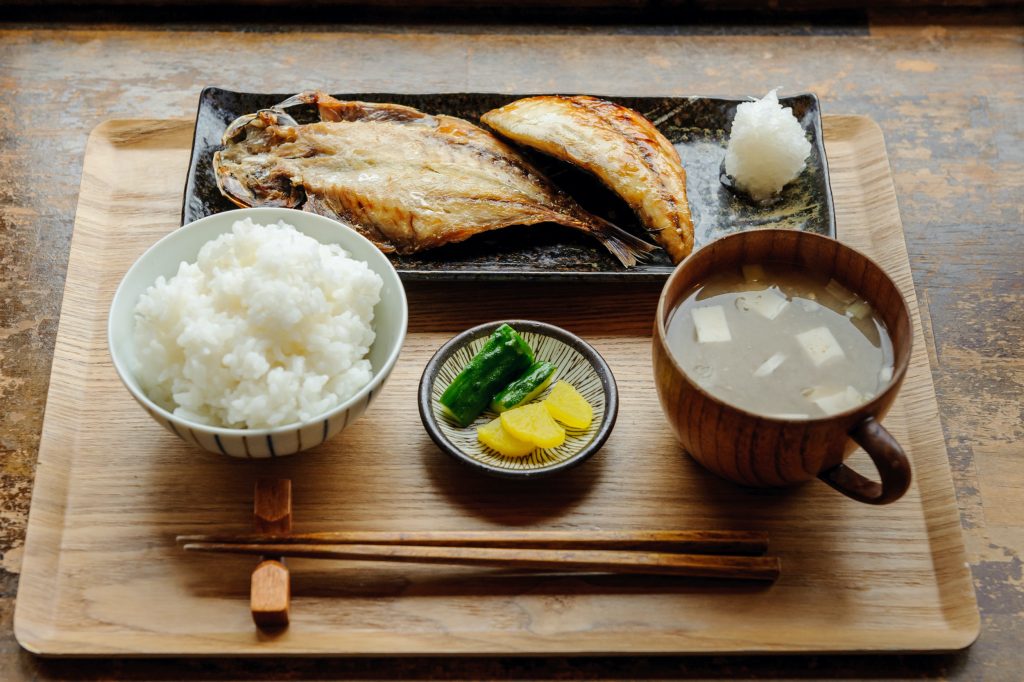
From traditional accompaniments to innovative culinary uses, tsukemono continue to inspire chefs and food lovers around the world. Yet, their significance goes beyond taste and presentation—it’s deeply connected to a larger global movement celebrating fermentation. Let’s take a closer look at why fermented tsukemono have captured such worldwide attention.
Traditional Japanese Meals with Tsukemono
In Japan, tsukemono are traditionally served as side dishes alongside steamed rice, miso soup, and grilled fish. They provide a refreshing contrast in flavor and texture, balancing richer or milder dishes. A typical Japanese meal might include a small assortment of tsukemono to cleanse the palate and add color to the plate, enhancing the overall dining experience.
Modern Twists: From Cheese Boards to Tsukemono Tapas
Chefs and home cooks worldwide are creatively integrating tsukemono into contemporary cuisine. Tsukemono can be paired with cheeses, creating a fusion of salty, tangy, and creamy flavors ideal for charcuterie boards. Additionally, tsukemono tapas—small plates featuring various pickled vegetables—are gaining popularity in casual dining, showcasing the versatility of these Japanese pickles in global culinary settings.
Tsukemono Cucumber Variations Without a Recipe
Cucumber tsukemono are especially popular due to their crisp texture and refreshing taste. Without diving into specific recipes, you can enjoy them in many ways: lightly pickled with salt and kombu seaweed for a quick snack, or fermented longer with chili peppers and garlic for more complex flavors. These simple variations highlight the adaptability of tsukemono cucumber to suit diverse tastes and occasions.
Why Fermented Tsukemono Matter in a Global Food Culture
Understanding tsukemono’s role on the world stage highlights how this humble pickle embodies both cultural heritage and modern food trends.
Japanese Pickles vs Western Pickles
While Western pickles typically involve vinegar-based brining, Japanese tsukemono encompass a wider range of techniques including fermentation with lactic acid bacteria. This difference leads to more diverse flavors, textures, and health benefits. Tsukemono often have a subtler sourness and a depth of umami that distinguishes them from many Western-style pickles.
The Growing Trend of Fermented Cuisine
Fermented foods are experiencing a renaissance worldwide, embraced for their taste, preservation qualities, and potential digestive benefits. Tsukemono fit perfectly into this trend, offering authentic examples of centuries-old fermentation methods. Their rising popularity reflects a global interest in sustainable food practices and gut-friendly diets.
Cultural Education Through Culinary Exchange
Tsukemono serve as delicious ambassadors of Japanese culture, introducing people to traditional food values and fermentation science. Through culinary exchange programs, workshops, and travel experiences, more people outside Japan are learning how tsukemono are made and enjoyed, deepening cultural understanding and appreciation.
▼You too can participate in fermented food study abroad programs and workshops in Japan.
Learn More: Join Our Newsletter & Explore Japan’s Fermentation
If you’re fascinated by tsukemono and Japanese fermentation, subscribe to our newsletter for:
- Expert articles on fermentation knowledge etc.
- Invitations to workshops and tasting events.
- Access to Japanese fermentation products and supplies.
Discover the world of tsukemono and bring a taste of Japan’s rich culinary tradition into your kitchen.
” 耀 Hikari ” – gastronomy
Conclusion: Embrace Tsukemono for Flavor, Tradition, and Wellness
Tsukemono are more than just side dishes—they are vibrant expressions of Japanese heritage and fermentation mastery. Their rich diversity, health-supporting microbes, and unique flavors make them ideal for anyone interested in traditional foods, gut health, or culinary creativity. Whether you enjoy tsukemono in a traditional meal or experiment with modern pairings, they offer a meaningful connection to Japan’s food culture. Explore tsukemono today and unlock a world of taste and wellness.
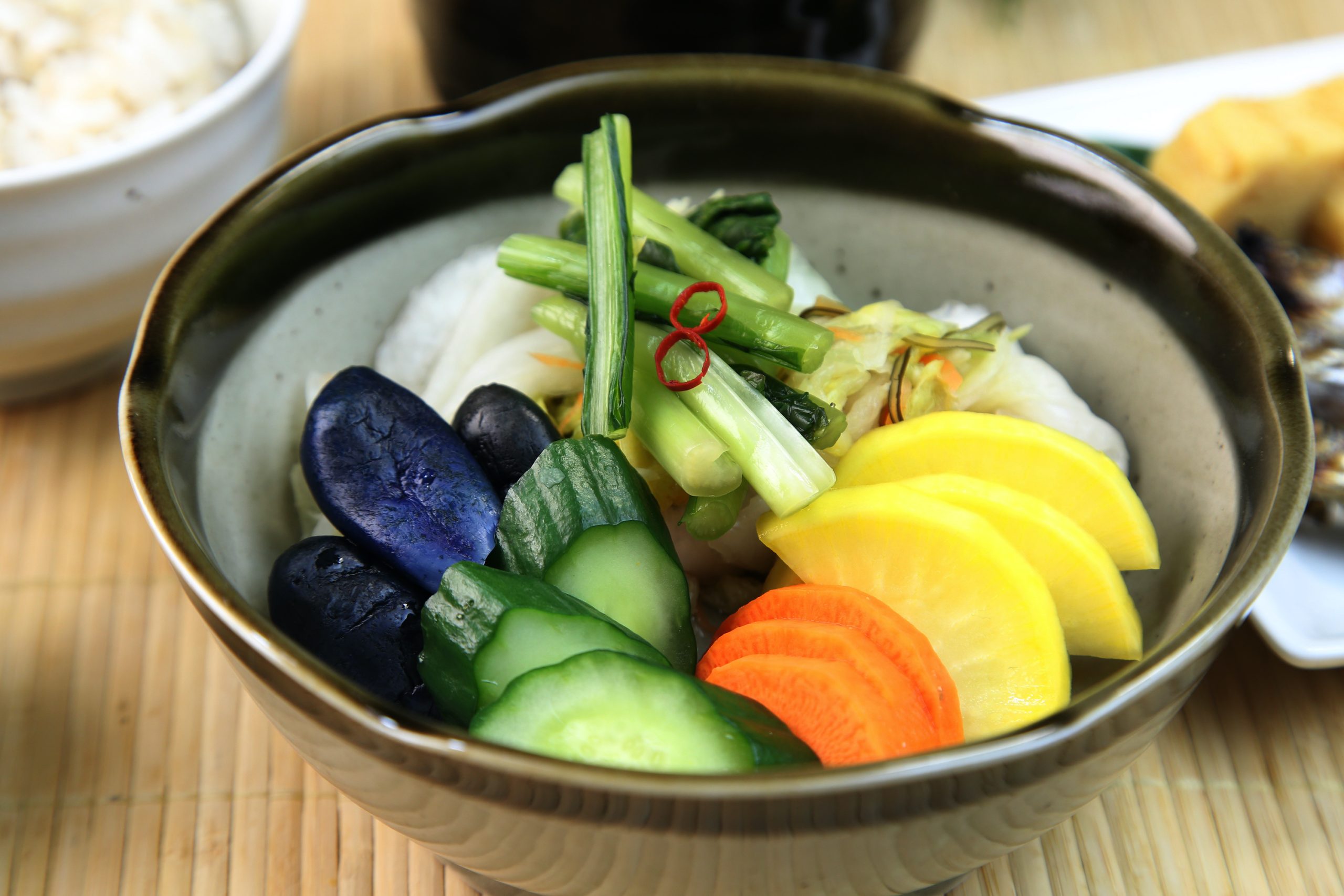
No responses yet